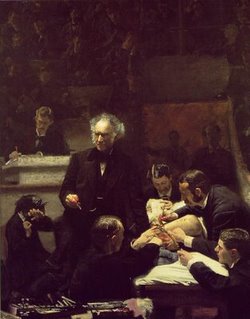
A great deal of controversy has been brewing recently over decisions by museums to sell parts of their permanent collection, or deaccessioning. First, came the decision by the Pennsylvania Academy of the Fine Arts to sell Thomas Eakins' The Cello Player to purchase an interest in The Gross Clinic.
Now, it seems the Albright-Knox Art Gallery in Buffalo NY has decided to sell a great deal of its permanent antiquities collection to allow it to purchase more contemporary works. The Buffalo News has a list of the works for auction here. Among the works are classical sculpture, Chinese porcelain, a Benin bronze, and a number of other works.
Colin Dabkowski of the Buffalo News has an article in yesterday's Buffalo News which indicates a group of concerned citizens called the "Buffalo Art Keepers" are going to challenge the sale in court. Donn Zaretsky at the Art Law blog has more, as does Lee Rosenbaum. Rosenbaum labels the dispute a "showdown", but that may be a bit generous for the "Art Keepers". I agree with Zaretsky that it will be extremely difficult for them to prevent the sale. What it will do is raise the cost, both in terms of legal expenses and public opinion, in deaccessioning.
Richard Stanton, the counsel representing the "Art Keepers" says "They intend to protect the membership's interest in the collection and see that the museum follows its own mission statement and governing rules before they sell off masterpieces of art which have been assembled over the past 140 years." Perhaps so, and I'll freely admit I'm not an expert in museum governance regulations, but wouldn't there be some kind of version of the Business Judgment Rule for museums. In the corporate context, the Business judgment rule states that courts will not step in and interfere with a corporate board's business decisions. Surely, a similar situation must be at play here.
The "Art Keepers" are arguing that the museum has collected and displayed ancient art and antiquities in the past, but has recently changed its mission to focus on contemporary art. I think the neo-classical design of the museum itself would seem to speak to an earlier intention to display older works. However, shouldn't a museum be able to shift positions? Do we want to box an institution in and prevent it from shifting a mission in the future? What the dispute really involves is a frustration with members of the public that the Albright-Knox has shifted away from displaying antiquities, and towards contemporary art. We may argue with that decision as a matter of personal taste, but museums should be able to switch positions, and we want our cultural institutions to have some degree of flexibility.
Another dimension to this decision may be that the recent string of repatriation requests by the Italians and Greeks may encourage a museum, especially one needing funds, to sell their antiquities before a source nation makes a very public and very unpleasant request for their return. I do not know the provenance of the Benin bronze the museum has decided to sell, but many of them were taken under less-than-savory circumstances in the 19th century in the Punitive Expidition of 1897. Nigeria has a compelling ethical case to be made for their return.
Limiting museum decision-making could severely restrict our ability to have strong and viable cultural institutions. You risk a great deal by forcing an institution to repatriate objects while also preventing it from selling and managing its collection in a responsible manner.





